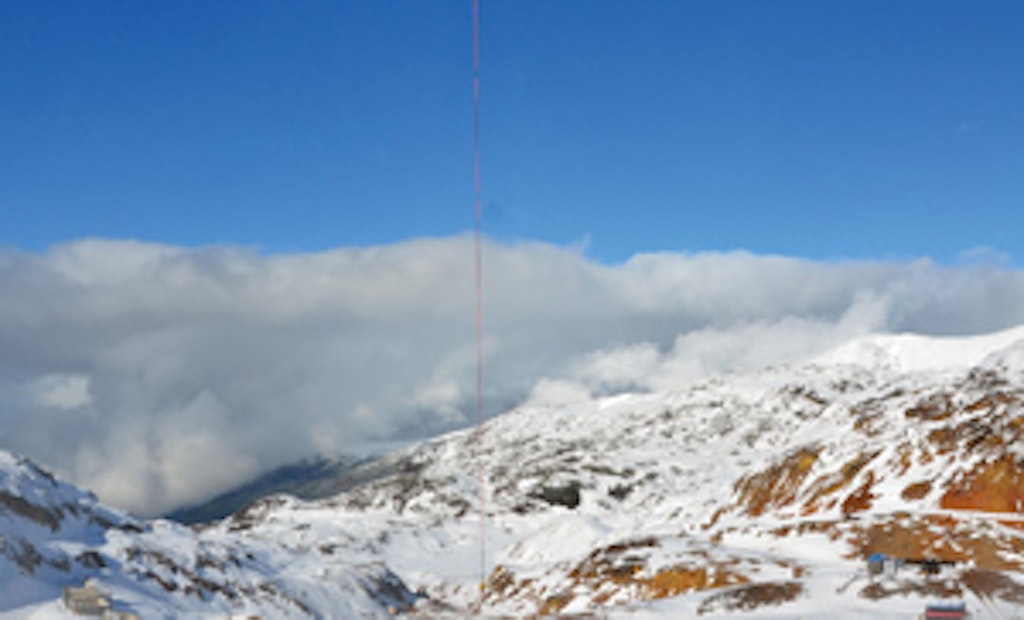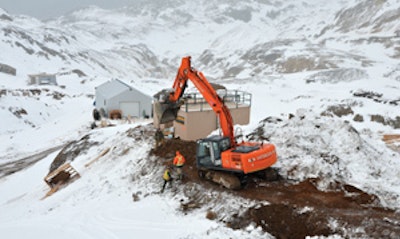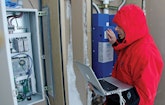
Interested in Systems/ATUs?
Get Systems/ATUs articles, news and videos right in your inbox! Sign up now.
Systems/ATUs + Get AlertsGold miners at the remote Brucejack 150-man camp north of Stewart, B.C., had to dig latrines by hand. Helicopters air-lifted preassembled timber outhouses from the staging point, Grand Duke, 30 miles and one mountain range away.
Users found that frigid air blew in under the ground seal on the privies. When the hole was full, they backfilled by hand, dug a new pit, and summoned the helicopter to move the outhouse.
Camp manager Rob Cote consulted with Eerik Lilles, P.E., of Wildernest Systems in Smithers on ways to improve lavatory conditions before the next winter. Lilles saw that most large conventional systems were not feasible. “We couldn’t fly in concrete and mix trucks and build something,” he says. “Furthermore, the owners didn’t want anything permanent or semi-permanent.”
Lilles had used AdvanTex AX100 textile treatment modules from Orenco Systems in other designs and knew about the AX-Mobile, a portable, aboveground system using recirculating packed bed filters.
“A 40-foot container serves 150 people but would have to be dragged across the glaciers by a tracked Snow Cat in spring,” says Lilles. “We opted for two 20-foot containers that could be flown in.” The fully plumbed units enabled workers to use flush toilets instead of pit latrines.
Site conditions
Soils are super-fine silt till with groundwater at the surface. The camp sits at the top of Knipple Glacier, just south of Brucejack Lake. The Pacific Ocean moderates winter temperatures to minus 4 degrees F or above. High winds blow massive amounts of snow through the mountain pass.
System components
Lilles used a flow rate of 25 gpd per person to size the 5,000 gpd system. It includes:
Automatic grease trap
90-gallon fiberglass wet well with 1/2 hp, 50 gpm Grundfos duplex 2-inch solids handling pump
AX-Mobile-20 treatment system in two 20- by 8- by 10-foot insulated fiberglass containers
Two Hallet-30 UV disinfection systems from UV Pure Technologies
System operation
Wastewater and graywater flow 200 feet through a 4-inch insulated PVC gravity line to the 72-inch wet well. On demand, 50-gallon doses are pumped through a 2-inch insulated pipe to the 7,500-gallon T-Max primary container with insulation embedded in its 4-inch-thick molded fiberglass walls. The container is the septic tank.
After liquid passes through an FT1254 effluent filter, it flows through a 4-inch insulated pipe to the inlet of the three-compartment AX-Mobile container serving as the tank for the treatment system.
As influent enters the 3,000-gallon recirculation-blending chamber, it mixes with filtrate dripping from the hanging textile media. A pump in the recirculation-pump chamber at the opposite end of the inlet draws blended influent through a one-way transfer line, sending 100 gallons per hour to a manifold above the textile media.
Orenco spin nozzles distribute the liquid to the media for further treatment. As it percolates through the textile sheets, microorganisms remove impurities. With each dose, some effluent drips into the 1,500-gallon recirculation-filtrate chamber before dispersal.
A baffle divides the flow between the recirculation-blend and recirculation-filtrate chambers, and a recirculation-return valve controls the liquid levels. No wastewater passes into the second chamber without first flowing through the media. Peak hydraulic retention time is two-and-a-half days.
Effluent in the final clear well averages 60 degrees F. “Hot water from the shower, laundry, and kitchen facilities keeps it from becoming too cold,” says Orenco engineer-in-training Ted E. Kulongoski. “Should it fall to 40 degrees or below, we have an optional heating unit.”
Before discharge, liquid passes through the UV disinfection unit at the rear of the container. Effluent is expected to average 10/10 mg/L BOD and TSS with zero pathogens and runs downhill through an insulated 2-inch line. Camp generators power the system.
Installation
Lilles ordered the components and coordinated trucking them to Grand Duke, a 60-minute drive north of Stewart on a rugged service road. Meanwhile, camp workers leveled the top of a small knoll with a 200 LC X-axis Hitachi tracked excavator, dug the hole for the wet well, and bedded the area with six to eight inches of rock from the site.
When the containers arrived in October, Cote sent a heavy-lift helicopter to carry them over the mountains, a 12-minute journey. “Each module weighs more than 6,000 pounds, and the helicopter’s carry capacity was 5,500 pounds,” says Kulongoski. “We had to remove about 500 pounds of material and textile before it could lift off.”
The pilot lowered the units onto the bedded pad and next to each other, then returned with the extra cargo and components inside a large net slung beneath the helicopter. While workers buried the wet well – a fiberglass riser with a bottom – at grade next to the T-Max container, Lilles hooked up and tested the components. Kulongoski trained the camp operators in the system’s operation and maintenance.
The treatment unit has no control room. The prewired control panel at the back of the container has a touchscreen on the outside of the door, enabling operators to check system performance at a glance. Snow management personnel shovel any accumulation more than 12 inches, keeping everything accessible.
Until the camp was wired for satellite Internet connection, Lilles asked the operators to check the control panel daily for alarms and to take the temperature of the effluent weekly.
Maintenance
Wildernest Systems handles maintenance and monitors the system remotely. The control panel had no problem handling the power outage when the camp turned off the generator once a week to change the oil.







